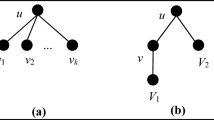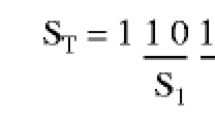Abstract
A binary unordered tree is a tree where each internal node has two children and the relative order of the subtrees of a node is not important (i.e. two trees are different if they differ only in the respective ordering of subtrees of nodes). We present a new method to generate all binary rooted unordered trees with n internal nodes, without duplications, in O(log n) time.
Access this chapter
Tax calculation will be finalised at checkout
Purchases are for personal use only
Preview
Unable to display preview. Download preview PDF.
Similar content being viewed by others
References
Beyer, T., Hedetniemi, M.: Constant Time Generation of Rooted Trees. SIAM Journal on Computing 9, 706–712 (1980)
Kozina, A.V.: Coding and Generation of NonisomorphicTrees. Cybernetics 25, 645–651 (1979)
Kubicka, E., Kubicki, G.: Constant Time Algorithm for Generating Binary Rooted Trees. Congressus Numerantium 90, 57–64 (1992)
Li, G., Ruskey, F.: The Advantages of Forward Thinking in Generating Rooted and Free Trees. Extended Abstract SODA (1999)
McKay, B.D.: Isomorph-Free Exhaustive Generation. Journal of Algorithms 26, 306–324 (1998)
Murtagh, F.: Counting dendrograms: a survey. DiscreteApplied Mathematics 7, 191–199 (1984)
Pallo, J.M.: Enumerating, Ranking and Unranking Binary Trees. The Computer Journal 29, 171–175 (1986)
Pallo, J.M.: Lexicographic Generation of Binary Unordered Trees. Pattern Recognition Letters 10, 217–221 (1989)
Wright, R.A., Richmond, B., Odlyzko, A., McKay, B.D.: Constant Time Generation of Free Trees. SIAM Journal on Computing 15, 540–548 (1986)
Author information
Authors and Affiliations
Editor information
Editors and Affiliations
Rights and permissions
Copyright information
© 2004 Springer-Verlag Berlin Heidelberg
About this paper
Cite this paper
Effantin, B. (2004). Generation of Unordered Binary Trees. In: Laganá, A., Gavrilova, M.L., Kumar, V., Mun, Y., Tan, C.J.K., Gervasi, O. (eds) Computational Science and Its Applications – ICCSA 2004. ICCSA 2004. Lecture Notes in Computer Science, vol 3045. Springer, Berlin, Heidelberg. https://doi.org/10.1007/978-3-540-24767-8_68
Download citation
DOI: https://doi.org/10.1007/978-3-540-24767-8_68
Publisher Name: Springer, Berlin, Heidelberg
Print ISBN: 978-3-540-22057-2
Online ISBN: 978-3-540-24767-8
eBook Packages: Springer Book Archive




